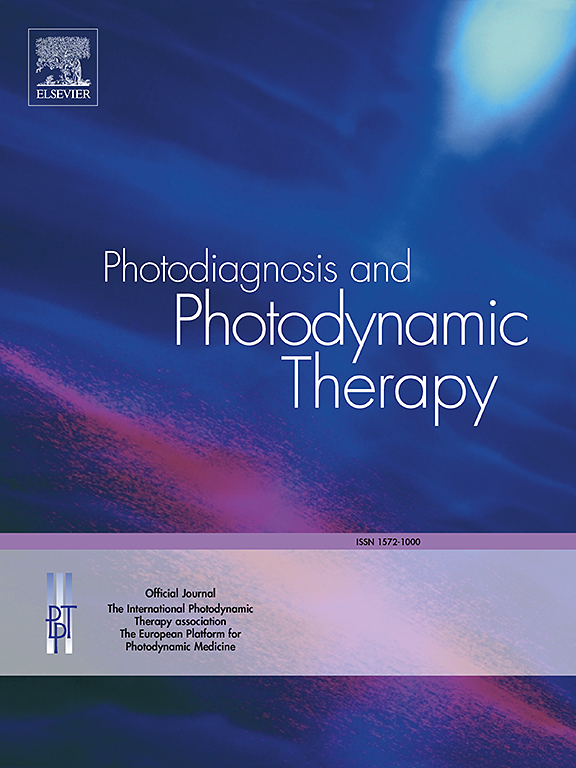Effects of aminolevulinic acid photodynamic therapy combined with antibiotics on Mycobacterium abscessus skin infections: An in vitro and in vivo study
IF 2.6
3区 医学
Q2 ONCOLOGY
引用次数: 0
Abstract
Background
Mycobacterium abscessus skin infections have emerged as a major medical issue. Traditional antibiotic treatments are challenging, prolonged, and often lead to recurrence, creating an urgent need for new therapies. This study investigates the effectiveness of aminolevulinic acid photodynamic therapy (ALA-PDT) combined with antibiotics in treatmenting M. abscessus, using both in vitro and in vivo methods.
Methods
We treated eight patients with M. abscessus skin infections following cosmetic surgery, using ALA-PDT (ALA concentration: 20 %; red light: 80 J/cm2) combined with oral or intravenous antibiotics,including clarithromycin, moxifloxacin and amikacin, to treat 8 patients with M. abscessus skin infection after medical cosmetic surgery, and assessed the treatment outcomes. Additionally, four bacterial strains (MAB-A1, MAB-A2, MAB-B1, and MAB-B2) isolated from patients were tested in vitro for ALA-PDT efficacy to determine the optimal ALA-PDT dosage. Furthermore, the strains’ single colony morphology, biofilm formation, and genome characteristics of were analyzed to explore the factors influencing ALA-PDT's bactericidal effects. Finally, a combined ALA-PDT and antibiotics sterilization experiment was conducted in vitro.
Results
Clinically, ALA-PDT combined with antibiotics showed strong efficacy in treating M. abscessus skin infections, with no recurrence observed during follow-up. In vitro, ALA-PDT effectively killed M. abscessus, although MAB-B1 and MAB-B2 required a higher ALA-PDT dose compared with MAB-A1 and MAB-A2. Compared to MAB-A1 and MAB-A2, MAB-B1 and MAB-B2 exhibited stronger biofilm formation capabilities and bacterial virulence as well as genome mutations primarily affecting fatty acid synthesis and metabolism, potentially explaining their increased ALA-PDT dosage requirement. Notably, the combination of ALA-PDT and antibiotics exerted markedly higher bactericidal effects in vitro compared with antibiotics alone.
Conclusions
ALA-PDT combined with antibiotics emerged as an effective treatment for M. abscessus skin infections. However, optimal dosage and antibiotic combinations should be tailored to the characteristics of specific clinical strains.
氨基乙酰丙酸光动力疗法联合抗生素对脓肿分枝杆菌皮肤感染的影响:一项体外和体内研究。
背景:皮肤脓肿分枝杆菌感染已成为一个重要的医学问题。传统的抗生素治疗难度大、疗程长,而且经常导致复发,因此迫切需要新的疗法。本研究采用体外和体内方法,研究了氨基乙酰丙酸光动力疗法(ALA-PDT)联合抗生素治疗脓胸霉菌的效果:我们使用 ALA-PDT(ALA 浓度:20%;红光:80J/cm2)联合口服或静脉注射抗生素(包括克拉霉素、莫西沙星和阿米卡星)治疗了 8 例医学美容手术后皮肤感染脓肿疽杆菌的患者,并评估了治疗效果。此外,还对从患者身上分离出的四种细菌菌株(MAB-A1、MAB-A2、MAB-B1 和 MAB-B2)进行了 ALA-PDT 体外疗效测试,以确定 ALA-PDT 的最佳剂量。此外,还分析了菌株的单菌落形态、生物膜形成和基因组特征,以探讨影响 ALA-PDT 杀菌效果的因素。最后,在体外进行了ALA-PDT与抗生素联合杀菌实验:结果:在临床上,ALA-PDT与抗生素联用对治疗脓肿霉菌皮肤感染有很好的疗效,随访期间未发现复发。在体外,ALA-PDT 能有效杀灭脓肿霉菌,但与 MAB-A1 和 MAB-A2 相比,MAB-B1 和 MAB-B2 需要更高的 ALA-PDT 剂量。与 MAB-A1 和 MAB-A2 相比,MAB-B1 和 MAB-B2 表现出更强的生物膜形成能力和细菌毒力,以及主要影响脂肪酸合成和代谢的基因组突变,这可能是它们需要更多 ALA-PDT 剂量的原因。值得注意的是,与单独使用抗生素相比,ALA-PDT 和抗生素联合使用在体外发挥的杀菌效果明显更高:结论:ALA-PDT 与抗生素联用是治疗脓肿霉菌皮肤感染的有效方法。结论:ALA-PDT 与抗生素联合使用可有效治疗脓肿霉菌皮肤感染,但最佳剂量和抗生素组合应根据特定临床菌株的特点而定。
本文章由计算机程序翻译,如有差异,请以英文原文为准。
求助全文
约1分钟内获得全文
求助全文
来源期刊

Photodiagnosis and Photodynamic Therapy
ONCOLOGY-
CiteScore
5.80
自引率
24.20%
发文量
509
审稿时长
50 days
期刊介绍:
Photodiagnosis and Photodynamic Therapy is an international journal for the dissemination of scientific knowledge and clinical developments of Photodiagnosis and Photodynamic Therapy in all medical specialties. The journal publishes original articles, review articles, case presentations, "how-to-do-it" articles, Letters to the Editor, short communications and relevant images with short descriptions. All submitted material is subject to a strict peer-review process.
 求助内容:
求助内容: 应助结果提醒方式:
应助结果提醒方式:


